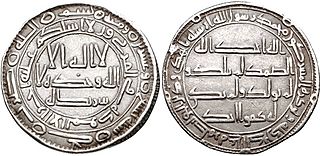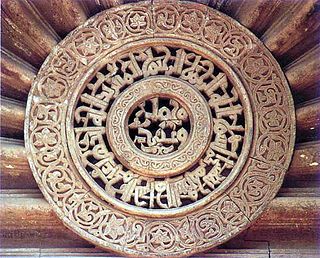Isma'il ibn Ja'far was the eldest son of Ja'far al-Sadiq and the sixth Imam in Isma'ilism. He carried the epithet of al-Mubarak, on the basis of which one of the earliest Isma'ili groups became designated as the Mubarakiyya.
In Shia Islam, the Imamah is a doctrine which asserts that certain individuals from the lineage of the Islamic prophet Muhammad are to be accepted as leaders and guides of the ummah after the death of Muhammad. Imamah further says that Imams possess divine knowledge and authority (Ismah) as well as being part of the Ahl al-Bayt, the family of Muhammad. These Imams have the role of providing commentary and interpretation of the Quran as well as guidance.

Zaydism is one of the three main branches of Shia Islam that emerged in the eighth century following Zayd ibn Ali‘s unsuccessful rebellion against the Umayyad Caliphate. Zaydism is typically considered to be a branch of Shia Islam that comes closest to the Sunni, although the "classical" form of Zaydism over the centuries had changed its posture with regard to Sunni and Shia traditions multiple times, to the point where interpretation of Zaydi as Shia is often based on just their acceptance of Ali as a rightful successor to Muhammad. Zaydis regard rationalism as more important than Quranic literalism and in the past were quite tolerant towards Sunni Shafiism, a religion of about half of the Yemenis.

Muhammad ibn Ali al-Baqir was the fifth imam in Shia Islam, succeeding his father, Ali al-Sajjad, and succeeded by his son, Ja'far al-Sadiq. His mother, Umm Abd Allah Fatima, was the daughter of Hasan, making al-Baqir the first imam who descended from both grandsons of Muhammad, namely, Hasan and Husayn.

ʿAlī ibn Muḥammad al-Hādī was a descendant of the Islamic prophet Muhammad and the tenth Imam in Twelver Shia, succeeding his father, Muhammad al-Jawad. Born in Medina in 828, Ali is known with the titles al-Hādī and al-Naqī. After the death of his father in 835, most followers of al-Jawad readily accepted the imamate of Ali, who was still a child at the time. Drawing parallels with the story of young Jesus in the Quran, Twelver sources attribute an exceptional innate knowledge to Ali which qualified him for the imamate despite his young age.
Hasan ibn Ali ibn Muhammad, better known as Hasan al-Askari, was a descendant of the Islamic prophet Muhammad. He is regarded as the eleventh of the Twelve Imams, succeeding his father, Ali al-Hadi. Hasan Al-Askari was born in Medina in 844 and brought with his father to the garrison town of Samarra in 848, where the Abbasid caliphs held them under close surveillance until their deaths, even though neither were politically active. After the death of al-Hadi in 868, the majority of his following acknowledged his son, al-Askari, as their next Imam. Al-Askari's contact with the Shia population was restricted by the caliphs and instead he communicated with his followers through a network of representatives. He died in Samarra in 873–874 at the age of about twenty-eight and was buried in the family home next to his father, which later developed into al-Askari shrine, a major center for Shia pilgrimage. Shia sources commonly hold the Abbasids responsible for the death of al-Askari and his father. A well-known early Shia commentary of the Quran is attributed to al-Askari.
Muhammad ibn Hasan al-Mahdi is believed by the Twelver Shia to be the last of the Twelve Imams and the eschatological Mahdi, who will emerge in the end of time to establish peace and justice and redeem Islam.

The Alids are those who claim descent from Ali ibn Abi Talib, the fourth Rashidun caliph and the first imam in Shia Islam. Ali was also the cousin and son-in-law of the Islamic prophet Muhammad. The main branches are the Hasanids and Husaynids, named after Hasan and Husayn, the eldest sons of Ali from his marriage to Fatima, the daughter of Muhammad. As the progeny of Muhammad, they are revered by all Muslims. The Alids have led various movements in Islam, and a line of twelve Alids are the imams in Twelver Shia, the largest Shia branch.
The Mahdi is a prominent figure in Islamic eschatology who is believed to appear at the End of Time to rid the world of evil and injustice. He is said to be a descendant of Muhammad, who will appear shortly before Jesus and will lead the Muslim Ummah to rule the entire world.
Abu ʿAlī al-Ḥusayn ibn Aḥmad ibn ʿAbd Allāh ibn Muḥammad ibn Ismāʿīl, also known as al-Zakī, al-Raḍī and al-Muqtadā al-Hādī, was a descendant of the Islamic prophet Muhammad and the tenth of the Isma'ili Imams, succeeding his father, Muhammad al-Taqi. Before his death in 881, he entrusted the care of his son and successor, Abd Allah al-Mahdi who was then around 8 years old to his full brother, Sa'id al-Khayr, also known as Abu'l-Shalaghlagh.
The Kaysanites were a Shi'i sect of Islam that formed from the followers of Al-Mukhtar. They traced Imamate from Muhammad ibn al-Hanafiyyah and his descendants. The name Kaysaniyya was most likely derived from the name of Mukhtar's chief guard, Abu Amra Kaysan.
Abū Jaʿfar Muḥammad ibn ʿAlī al-Hādī was a descendant of the Islamic prophet Muhammad and the son of Ali al-Hadi and the brother of Hasan al-Askari, the tenth and eleventh Imams in Twelver Shia, respectively. Some may have expected him to succeed his father al-Hadi to the imamate but he predeceased him in the garrison town of Samarra in Iraq, where al-Hadi was kept under surveillance by the Abbasids. His shrine is located near Baghdad, between Samarra and Kadhimiya. Considered a sacred site in Twelver Shia, his shrine was targeted by Sunni militants in 2016 in a deadly attack on its pilgrims.
The Muhammadite Shia were a Shia sect who believed that due to the supposed lack of a son for Hasan al-Askari, they had to rethink the legitimacy of his Imamate. Therefore, they instead believed in the Imamate of his brother Muhammad al Askari ibn Imam Ali al-Hadi, who died 7 years before the death of his father. However, the Muhammadites denied the death of Muhammad al Askari ibn Imam Ali al-Hadi, and claimed that his father had pointed to him and appointed him as the Imam to succeed himself, and had mentioned him by his name and person. These beliefs, falsely according to them, are what were agreed by all.
The Waqifite Shia were a Shia sect who accepted the Imamate of Musa al-Kadhim, but refused to accept the Imamate of his successor Ali ar-Ridha.
Muhammad ibn Abd Allah al-Aftah ibn Ja'far al-Sadiq was a figure whose existence is contested: a portion of the Fathite Shia Muslims, believed that Muhammad was the son of Imam Abdullah al-Aftah, whom they believed to be the Imam after his father Ja'far al-Sadiq. This assertion is contested by others, including many Fathites, who believe that Abdullah died without issue.

Abd Allah ibn Mu'awiya was an Alid leader who started a rebellion against the Umayyad Caliphate at Kufa and later Persia during the Third Fitna.

The doctrine of the Imamate in Isma'ilism differs from that of the Twelvers because the Isma'ilis had living Imams for centuries after the last Twelver Imam went into concealment. They followed Isma'il ibn Ja'far, elder brother of Musa al-Kadhim, as the rightful Imam after his father, Ja'far al-Sadiq. The Ismailis believe that whether Imam Ismail did or did not die before Imam Ja'far, he had passed on the mantle of the imamate to his son Muhammad ibn Isma'il as the next imam.
Abū ʿAbd Allāh Jaʿfar ibn ʿAlī al-Hādī, also derisively known as al-Kadhdhāb in Twelver Shi'ism, was the third son of the tenth Twelver Shi'a Imam, Ali al-Hadi. He claimed to be an imam and established his own sect of followers, to whom he was known as al-Zakī.
The wokala were a networks of agents who were active from Ja'far al-Sadiq's time until the end of the Minor Occultation in 941 CE. The wikalah was responsible for the relations between imams and Shia Islam as well as collecting religious taxes.







